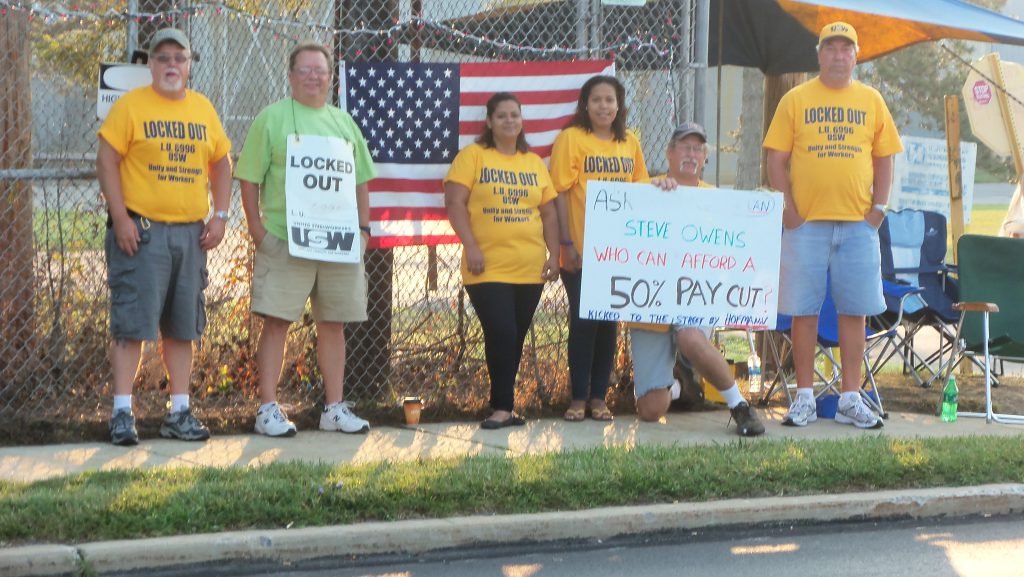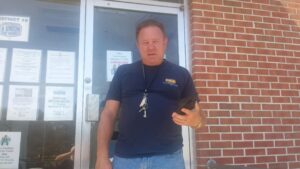
AAM’s own Dean Showers consulted on the Pulitzer Prize winner.
For 45 years Dean Showers labored for Hofmann Industries, a steel tubing manufacturer in Sinking Spring, Pa. Working in often dangerous conditions on the production line, Showers knew the risk of injury was high — a friend’s hand had been crushed by machinery — but these were risks he was willing to accept in return for a family-supporting wage and benefits.

As the president of United Steelworkers (USW) Local 6996 since 1999, Showers had seen jobs slowly disappear as companies abandoned their facilities in search of cheaper labor overseas. Hofmann Industries and the union had gone almost 20 years without labor strife until signs of trouble emerged in 2008.
With the removal of the plant’s two most productive mills under the cloak of night, Hofmann launched a six-year battle of wills between the company and its workers.
It is this struggle that informs Lynn Nottage’s play “Sweat,” which earned the playwright her second Pulitzer Prize in 2017 and brought the trauma of manufacturing job loss to Broadway. New York City’s The Public Theater is bringing the play to the communities in the Industrial Midwest impacted by trade action in the hopes of fomenting local discussions ahead of the mid-term elections. Running from Sept. 27 through Oct. 23, The Public Theater will stage the production in the industrial centers of Pennsylvania, Ohio, Michigan, Minnesota and Wisconson for free.
Ahead of the performances, Alliance for American Manufacturing (AAM) President Scott Paul interviewed Nottage and Showers for The Manufacturing Report, but there’s much more to his story left to tell.
Showers, who served as local president in 2011 when Hofmann demanded a 60 to 70 percent pay cut for its general laborers, found himself fighting to protect his workers while keeping the peace within the community.
Q: How did you begin working at Hofmann Industries?
A: “It was pretty easy to get a job right out of high school. There was plenty of work in manufacturing and in other occupations.
“I ended up going to Hofmann because they had a permanent night shift. You could work from 11 to seven and not change shifts, so I went there, and I went to school during the day. I had planned to stay there temporarily, but as it turns out I ended up there 45 years.”
Q: What was the work like?
A: “I remember in the ’70s there was a woman that did that job. It was a very hard job, and she was good at it. I remember I was like 18 or 19 years old, and she would say, ‘Don’t get frustrated.’ and ‘Hang in there.’ I could have left quite easily and said, ‘The heck with this. I’m doing something else.’ But, I think that woman was very instrumental in me staying there. She was a ‘If I can do this, you can do this’ kind of person, you know?
“Through the years, I worked up in [Hofmann’s plating department] and ended up becoming the department operator pretty quickly. I was very young. I was in my 20s, and then I became the shift operator. Then I stayed in that department, for the most part, all the time that I was there.”
Q: How did the conflict between Hofmann and its workers begin?
A: “As local union president, I think when I was elected we had 11 employers and somewhere around 2,500 members in the local, but over those years [from 1999 until the lockout in 2011], employer after employer would give us shutdown notice.
“Every year we would get a notice that somebody was shutting down or they were leaving. You would have literally anywhere from 40 to 200 workers that you would have to deal with on a lot of different things — trying to help them go to our all other employers and ask if they could absorb some people, and sometimes that could happen, but it wasn’t a lot. They would take on a few here or there.
“The whole job loss thing was in our face pretty much from 2000 right until the very end.”
“I believe it was in 2006, when we had a one-day strike [during contract negotiations with Hofmann]. The company was very upset when we rejected their offer, and we struck them. It really wasn’t over any money — it was over some other issues that weren’t addressed. We picketed one day, and the president of the company requested that we take the picket line down and come back in, and we’d work it out. And we did work it out. However, I think that was a defining moment.
“They, at some point after that 2006 contract and the one-day strike, [Hofmann] had a facility that they owned in Michigan, and they had shut it down five or six years earlier, and they decided, at some point, and maybe it was even before that one-day strike, that they were going to re-open that and take the majority of our work out and try to get away from the union.
“We didn’t know it at the time, but, I believe it was Easter in the spring of 2008, I got a call at home on Tuesday after the Easter holiday. It was odd because we had Good Friday for a holiday, and then the night shift was supposed to go back into work on Sunday night, which would have been Easter night. Their operations would have resumed Monday, but the company said that they weren’t going to start on Sunday night. They wanted to start with the day shift Monday. So, the night shift, they were off, and they knew it, so nobody reported to work that Easter night, which was kind of odd for them. But I got a call really early that Monday from one of our grievance chairman who was on day shift, who’s describing to me that they had taken two mills out of the department.”
“We knew something was up, and I asked him where they were at, and he said, ‘Well, I’m not going to tell because that’s irrelevant. We don’t know what we’re going to do with them yet. Blah blah blah…’ So, we ended up going back to work and didn’t really know more than that.
“I tell people all the time when they say, ‘This is hopeless. What are you doing there?’ I tell them we are standing up for everybody that goes to work for a living and if you agree with us, good, and if you don't, then I’m sorry, but I’m not apologizing.” Dean Showers
“Through the coming weeks, we started to get more details through curiosity and investigation. We found out they did go to this shutdown plant [that Hofman had reopened without unionized workers], and we also found out that they were doing work on it.
“We didn’t really know what that meant for us, but the writing was on the wall that something was going to be up.”
“And then in 2011, they sent [a letter initiating contract bargaining procedure] because they were ready to bargain. That [Michigan] plant was up and running then.
“We had already been downsized. We had lost well over 100 jobs. We were down to about 60 to 70 people working because that work had gone to Michigan now because they were up and running. Through that whole year of 2010, we were just bleeding jobs. Every month we would lose people.
“So, 2011, they went in with four proposals. One was a pay cut — about a 60 to 70 percent pay cut. You were asking people who were making $21, $22 per hour to make $10. And then the insurance was just absolutely atrocious. For myself, I was still insuring under the family plan, the co-pay each week was like $276. So, if you were a laborer making $10 an hour, you would gross $400, and you would lose $276 to your insurance. You’re basically working a 40-hour week to get about a $100 paycheck.
“It was actually pretty laughable.
“The other proposals were elimination of the pension and capping the pension, and elimination of our severance language.
“They stuck with that proposal for the entire lockout, which was over six years. Only after the sixth year, did we end up getting a little movement.”
Q: How did the workers and community handle the lockout? It had to have been difficult for everyone.
A: “Sometimes I felt like the bartender [from ‘Sweat’]. I did because they replaced us from day one. And the first day we were locked out, they had about a half a dozen people who went in. We knew they were replacement workers. By the end of that first week, they had about 20.
“I told our members on the picket line, ‘Look, there are people that are replacing us. It is what it is, but we’ve got to be smart.’ I don’t want to see anybody arrested because there were some very, very intense moments on the picket line.
“We picketed through cold, cold windy weather. That corner was windy because tractor trailers would go by in the cold.
“I’d run into people and they make jokes about us being in a tent over there, kind of comparing us to homeless people … even my own relatives. I ignored it, didn’t speak to them much after that, but it kind of belittled the situation not knowing what was going on.
“People would stop us all the time asking us ‘what the point was, just get over it, I don’t understand why you still picket after all this time, what can you really get out of it?’”
“But we knew that we'd probably never go back so we just decided that we were going to stay there until it ended one way or the other with a shutdown or with some kind of severance package or maybe we would go back, we didn't know. I tell people all the time when they say, ‘This is hopeless. What are you doing there?’ I tell them we are standing up for everybody that goes to work for a living and if you agree with us, good, and if you don't, then I’m sorry, but I’m not apologizing.”
Q: What do you think audiences will take away from the play during this fall tour?
A: “So, I think when people come to see this play, they know multiple relatives or friends that have gotten caught up in this labor market where companies are just chasing the cheapest labor. I think that is the message that hits home.
“That was the demise of the Rust Belt, and that’s why those states voted for Trump is because even if you are a doctor or a lawyer you still know many people or have relatives that were caught up in this whole people-looking-for-people-to-work-for-the-cheapest-possible-cost and a lot of the time the original start of the was NAFTA and these trade agreements, so people get a perspective on what is happening here domestically.
“I think that is what people are going to take away from seeing the play is that they are personally connected to what is happening. I don’t think that perspective has a red or blue stripe. I think that a lot of people agree on this. Trump managed to seize that, and he’s in the White House. That’s how powerful all of this is.”
Find out if “Sweat” is coming to a venue near you, and listen to the latest episode of The Manufacturing Report.
